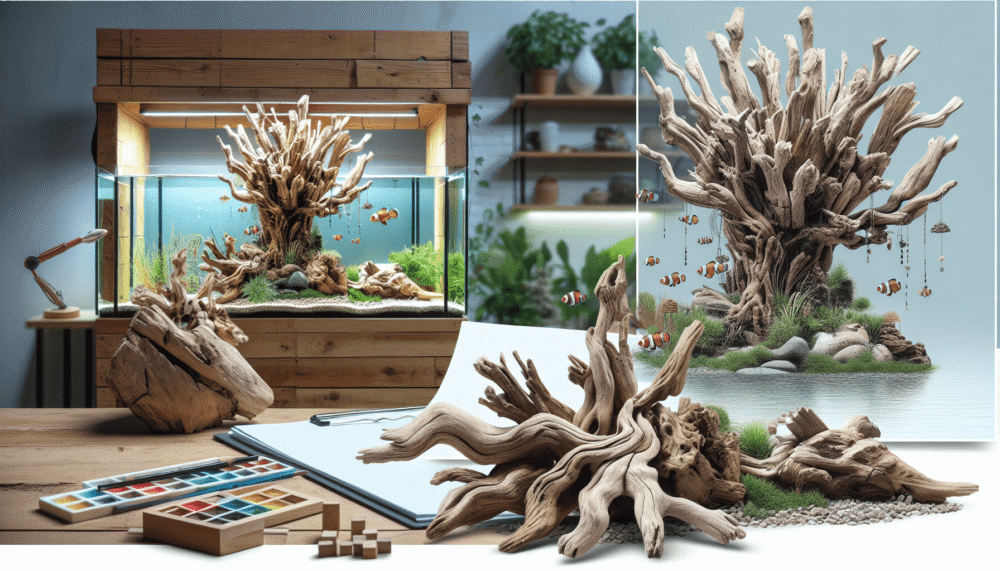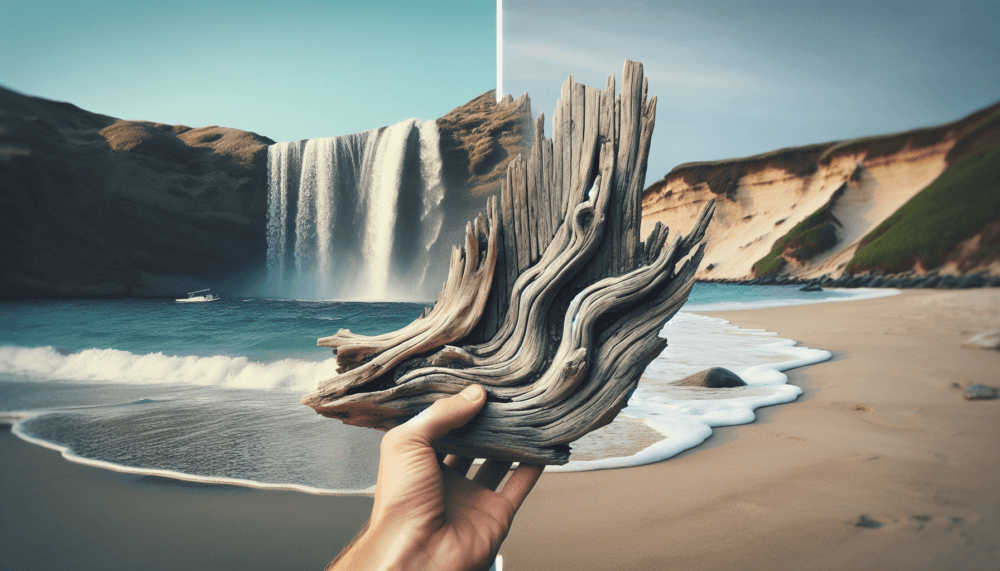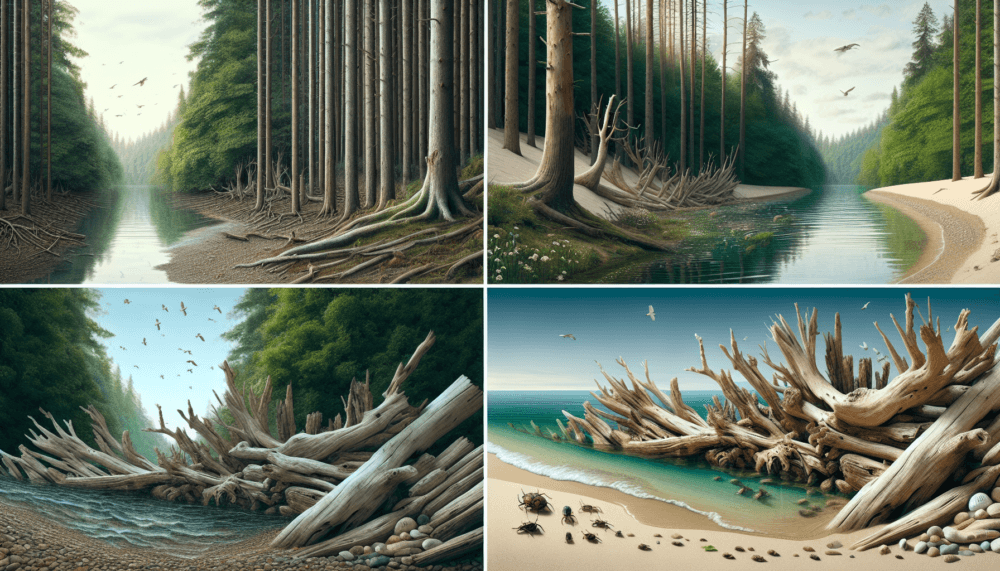So you’ve found a beautiful piece of driftwood that you want to incorporate into your home decor or use as a centerpiece in your aquarium, but you’re not exactly sure how to securely attach it. Don’t worry, we’ve got you covered. In this article, we’ll walk you through some simple and effective methods for attaching driftwood so you can confidently showcase its natural beauty in your space. Whether you’re a DIY enthusiast or a nature lover, we have solutions that will ensure your driftwood stays in place and becomes a stunning focal point.
Methods for Attaching Driftwood
Driftwood can make a beautiful addition to your home decor, whether you’re incorporating it into a gallery wall, creating a unique centerpiece, or even using it as a functional coatrack. But how exactly do you attach driftwood securely and safely? In this article, we will explore several methods for attaching driftwood, each with its own unique advantages and considerations.

Drilling and Screwing
One of the most reliable ways to attach driftwood is by drilling and screwing. This method provides a sturdy and long-lasting attachment, ensuring that your driftwood will stay securely in place. Here’s a step-by-step guide on how to use this method:
- Select the appropriate drill bit: Choose a drill bit that is slightly smaller in diameter than your screws to ensure a snug fit.
- Pre-drill holes into the driftwood: Mark the locations where you want to attach the driftwood, then carefully pre-drill holes using the selected drill bit.
- Position the driftwood in place: Hold the driftwood against the desired surface and mark the corresponding locations for the screws.
- Attach screws through the pre-drilled holes: Insert screws through the pre-drilled holes in the driftwood and drive them into the surface until they are fully secured.
- Tighten the screws securely: To ensure a strong attachment, tighten the screws fully using a screwdriver or drill.
This method is particularly useful when attaching heavy or large pieces of driftwood that require extra support.
Using Wire or Fishing Line
If you prefer more flexibility in the positioning of your driftwood or want a more discreet attachment method, using wire or fishing line is a great option. This method offers a minimalist look, allowing the driftwood to appear as if it is effortlessly suspended. Here’s how you can attach driftwood using wire or fishing line:
- Choose a sturdy wire or fishing line: Opt for wire or fishing line that is strong enough to support the weight of your driftwood.
- Wrap the wire or line securely around the driftwood: Start at one end of the driftwood and wrap the wire or line tightly around it several times, ensuring a secure hold.
- Create loops or knots to hang the driftwood: Depending on your desired hanging method, create loops or knots in the wire or line at both ends of the driftwood.
- Attach the other end to a hook or nail on the wall: Securely fasten the loops or knots to hooks or nails on the wall, adjusting the positioning as needed.
- Adjust the positioning and tighten as needed: Once the driftwood is attached, make any necessary adjustments to ensure it hangs straight, and tighten the wire or line as desired.
This method is ideal for creating a floating effect and works well for smaller driftwood pieces or when you want to achieve a more ethereal look.
Hot Gluing
Hot gluing is a quick and easy method for attaching driftwood that requires minimal tools and provides a strong hold. It is particularly useful when attaching lightweight driftwood pieces or when you want to avoid drilling holes. Follow these steps to attach driftwood using hot glue:
- Select a high-quality adhesive hot glue gun: Choose a hot glue gun that provides a strong and durable bond, suitable for the weight and size of your driftwood.
- Apply hot glue to the desired area on the driftwood: Using the hot glue gun, apply a generous amount of hot glue to the spot where you want to attach the driftwood.
- Press the driftwood firmly onto the desired surface: Immediately press the driftwood onto the desired surface, ensuring that it adheres to the hot glue.
- Hold it in place until the glue is completely dry and secure: Maintain gentle pressure on the driftwood until the hot glue is fully cooled and set, ensuring a secure attachment.
- Ensure the glued area can support the weight of the driftwood: Before hanging or displaying your driftwood, ensure that the hot glue attachment can support the weight of the driftwood to avoid any accidents or damage.
While hot gluing offers a convenient way to attach driftwood, it is important to consider the weight of your driftwood and the type of surface you are attaching it to. Hot glue may not provide sufficient support for heavy driftwood pieces or certain surfaces.
Using Epoxy Resin
Epoxy resin provides a strong and durable bond that is especially beneficial when attaching driftwood to smooth or non-porous surfaces. This method not only securely attaches the driftwood but also enhances its natural beauty. Follow these steps to attach driftwood using epoxy resin:
- Prepare the epoxy resin according to the manufacturer’s instructions: Read and follow the manufacturer’s instructions carefully for preparing the epoxy resin. This may involve mixing specific ratios of resin and hardener to activate the bonding properties.
- Apply the epoxy to both the driftwood and the desired surface: Using a brush or spatula, apply an even layer of epoxy resin to both the area on the driftwood where you want to attach it and the corresponding area on the desired surface.
- Press the driftwood onto the surface firmly: Immediately press the driftwood onto the desired surface, ensuring that it makes full contact with the layer of epoxy resin.
- Hold it in place until the epoxy cures completely: To achieve a strong bond, hold the driftwood in place until the epoxy resin cures completely. Follow the manufacturer’s instructions regarding cure time.
- Follow any additional instructions from the epoxy resin manufacturer: Some epoxy resins may require additional steps or precautions, such as applying a topcoat or allowing for post-cure, to ensure the best results. Be sure to read and follow any additional instructions provided by the manufacturer.
Epoxy resin offers a durable attachment method that is ideal for securing driftwood to surfaces such as glass, metal, or ceramic, where other methods may not adhere as effectively.

Nailing or Stapling
If you prefer a more traditional approach to attaching driftwood, nailing or stapling can provide a reliable and visually appealing attachment. This method works well when attaching driftwood to wooden surfaces or where a rustic aesthetic is desired. Follow these steps to attach driftwood using nails or staples:
- Choose appropriate nails or staples for the project: Select nails or staples that are long enough to penetrate both the driftwood and the desired surface without causing any damage or splitting.
- Position the driftwood in place: Hold the driftwood against the desired surface, ensuring it is aligned and positioned as desired.
- Drive nails or staples through the driftwood and into the desired surface: Use a hammer or staple gun to drive nails or staples through the driftwood and into the desired surface, ensuring a firm and secure attachment.
- Ensure the nails or staples are secure and provide sufficient support: Double-check that the nails or staples are fully inserted and provide adequate support for the weight of the driftwood. Consider using wood glue in conjunction with nails or staples for added stability.
Nailing or stapling is a classic method that complements the natural aesthetic of driftwood, especially when attaching it to wooden surfaces or incorporating it into DIY furniture projects.
Using Rope or Twine
For a coastal or bohemian vibe, attaching driftwood with rope or twine can add an organic and rustic touch to your decor. This method allows for easy adjustment and customization, making it an excellent choice for showcasing multiple driftwood pieces. Follow these steps to attach driftwood using rope or twine:
- Select a strong and durable rope or twine: Choose a rope or twine that can comfortably support the weight of your driftwood while offering an aesthetically pleasing appearance.
- Measure and cut the desired length of rope or twine: Determine the length you want your driftwood to hang from the wall or support, then cut the rope or twine accordingly.
- Create loops or knots around the driftwood: Securely tie loops or knots around the driftwood, allowing for sufficient support and adjustment as needed.
- Attach the other ends of the rope or twine to hooks or nails on the wall: Securely fasten the other ends of the rope or twine to hooks or nails on the wall, adjusting the positioning to achieve your desired arrangement.
- Adjust the positioning and tighten as needed: Once the driftwood is hung, you can easily adjust the positioning and tighten the rope or twine as desired to achieve the desired display.
Rope or twine offers a versatile and visually appealing attachment method, adding an organic and natural look to your driftwood arrangements.
Zip Ties or Cable Ties
For a quick and hassle-free attachment, zip ties or cable ties can be an excellent choice. This method is particularly suitable for larger or heavier driftwood pieces that require a secure and stable connection. Follow these steps to attach driftwood using zip ties or cable ties:
- Choose appropriate zip ties or cable ties for the project: Select zip ties or cable ties of suitable length and strength to handle the weight and size of your driftwood.
- Wrap the zip ties or cable ties tightly around the driftwood and desired surface: Start by wrapping the zip ties or cable ties tightly around the driftwood, ensuring a firm hold. Extend the ties to the desired surface and wrap them tightly around it as well.
- Pull the ties securely until the driftwood is firmly attached: Pull the zip ties or cable ties as tight as possible to securely fasten the driftwood to the desired surface.
- Trim off any excess length from the ties: Use scissors or a cutting tool to trim off any excess length from the zip ties or cable ties, ensuring a neat and tidy appearance.
- Ensure the ties are tightly secured and provide adequate support: Double-check that the zip ties or cable ties are tightly secured and provide sufficient support for the weight of the driftwood.
Zip ties or cable ties offer a practical and efficient method for attaching driftwood, especially when dealing with large or heavy pieces that require a strong and reliable connection.
Attaching with Brackets
When attaching larger or more intricate driftwood pieces, brackets can provide the necessary support and stability. This method ensures that your driftwood remains securely attached, even in high-traffic areas. Follow these steps to attach driftwood using brackets:
- Obtain suitable brackets for attaching the driftwood: Choose brackets that are appropriate for the size and weight of your driftwood, ensuring that they provide sufficient support.
- Position the brackets on the desired surface and driftwood: Place the brackets against the desired surface and the driftwood, aligning them for maximum stability and support.
- Secure the brackets in place using screws, nails, or bolts: Depending on the type of brackets used, securely attach them to the desired surface and the driftwood using suitable screws, nails, or bolts.
- Ensure the brackets are properly aligned for maximum stability: Double-check that the brackets are properly aligned and provide a sturdy platform for the driftwood. Adjust the positioning if necessary.
- Check the attachment for any wobbling or instability: Once the brackets are securely attached, test the stability of the attached driftwood. Make sure it doesn’t wobble or feel unstable.
Using brackets can be especially useful when attaching driftwood to walls or creating unique shelving units. They provide added security and ensure that your driftwood is displayed safely.
Using Adhesive Hooks
For a non-permanent attachment method that doesn’t require drilling, adhesive hooks can be a practical solution. This method is particularly useful when you want to attach smaller driftwood pieces or if you’re renting and need a removable option. Follow these steps to attach driftwood using adhesive hooks:
- Choose adhesive hooks suitable for the weight of the driftwood: Select adhesive hooks that can support the weight of your driftwood while adhering securely to the desired surface.
- Clean the desired surface: Thoroughly clean the area where you intend to place the adhesive hooks, removing any dust, dirt, or debris. This ensures a strong bond between the hooks and the surface.
- Peel off the backing of the adhesive hooks: Carefully remove the backing from the adhesive hooks, exposing the adhesive portion. Be cautious not to touch or contaminate the adhesive.
- Press the adhesive hooks firmly onto the desired surface: Apply gentle pressure to firmly press the adhesive hooks onto the desired surface, ensuring they make full contact.
- Hang the driftwood on the hooks: Hang or suspend the driftwood on the attached adhesive hooks, adjusting the positioning as desired.
Adhesive hooks offer a convenient and temporary attachment method for displaying driftwood, providing a secure hold without the need for tools or permanent alterations to the surface.
Wire Wrapping
For an artistic and visually appealing way to attach driftwood, consider wire wrapping. This method allows you to showcase driftwood while creating intricate patterns and designs. Here’s a step-by-step guide on how to attach driftwood using wire wrapping:
- Choose a pliable and durable wire for wrapping: Select wire that is easy to manipulate and can securely hold the weight of the driftwood. Copper, aluminum, or craft wire are ideal options.
- Wrap the wire tightly and securely around the driftwood: Begin by wrapping the wire tightly around the driftwood, starting at one end and working your way to the other, ensuring a secure hold.
- Weave the wire through the driftwood and create loops or knots: As you wrap the wire, weave it through the driftwood to create additional loops or knots for added stability and aesthetic appeal.
- Shape the wire to create a hanging or mounting mechanism: Manipulate the wire to form hooks, loops, or other shapes that will allow you to hang or mount the driftwood securely.
- Attach the wire to hooks or nails on the desired surface: Once you have shaped the wire and created a hanging or mounting mechanism, attach it securely to hooks or nails on the wall or desired surface.
Wire wrapping enables you to personalize your driftwood attachment, creating unique and eye-catching displays while ensuring a strong and secure connection.
By using these various methods for attaching driftwood, you can unleash your creativity and bring the beauty of nature into your home decor. Whether you opt for the traditional approach of drilling and screwing, the delicate beauty of wire wrapping, or the simplicity of adhesive hooks, the possibilities are endless. So go ahead, gather your driftwood collection, and start creating stunning and unique pieces that will surely mesmerize all who enter your space. Happy decorating!



















